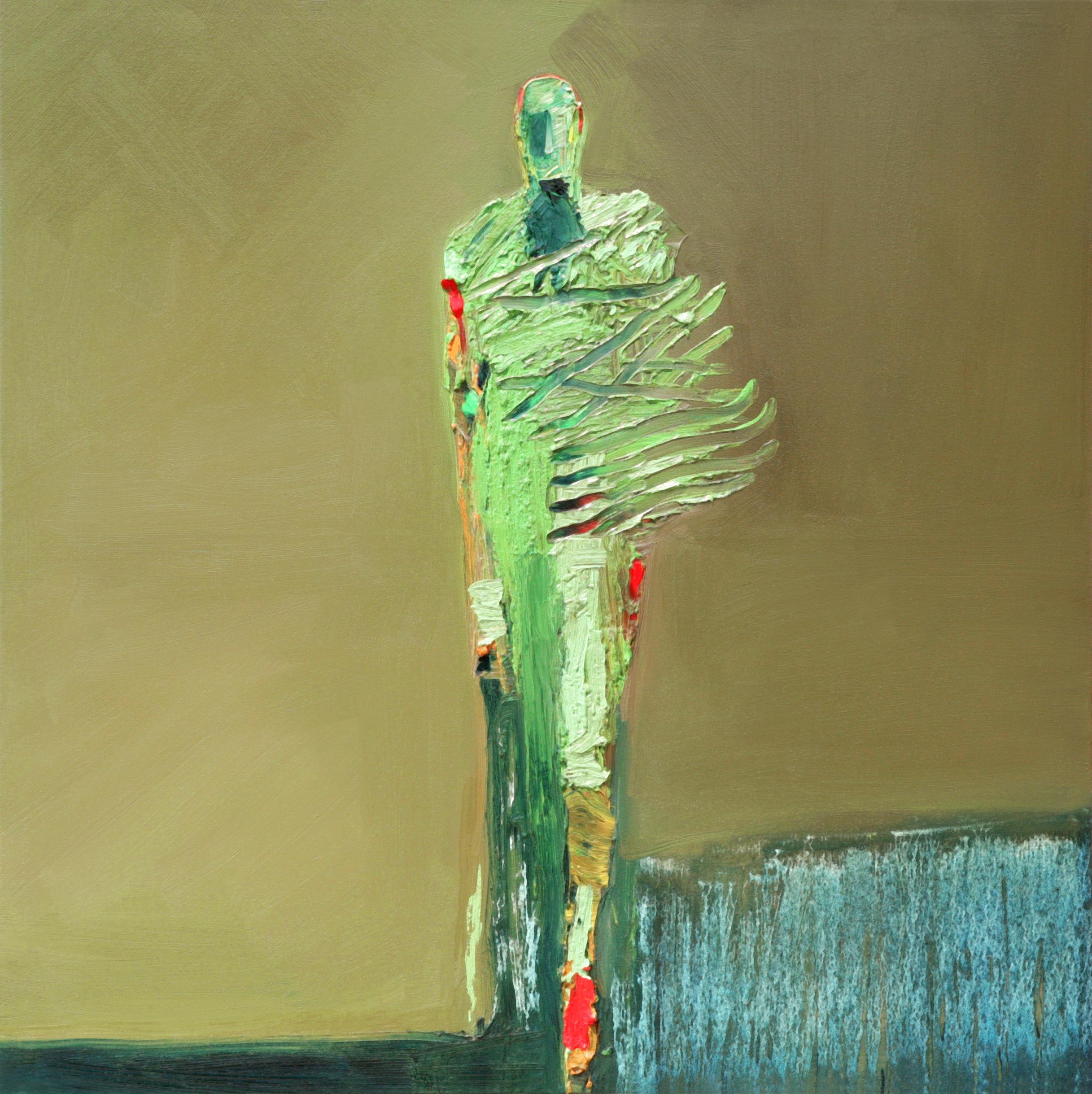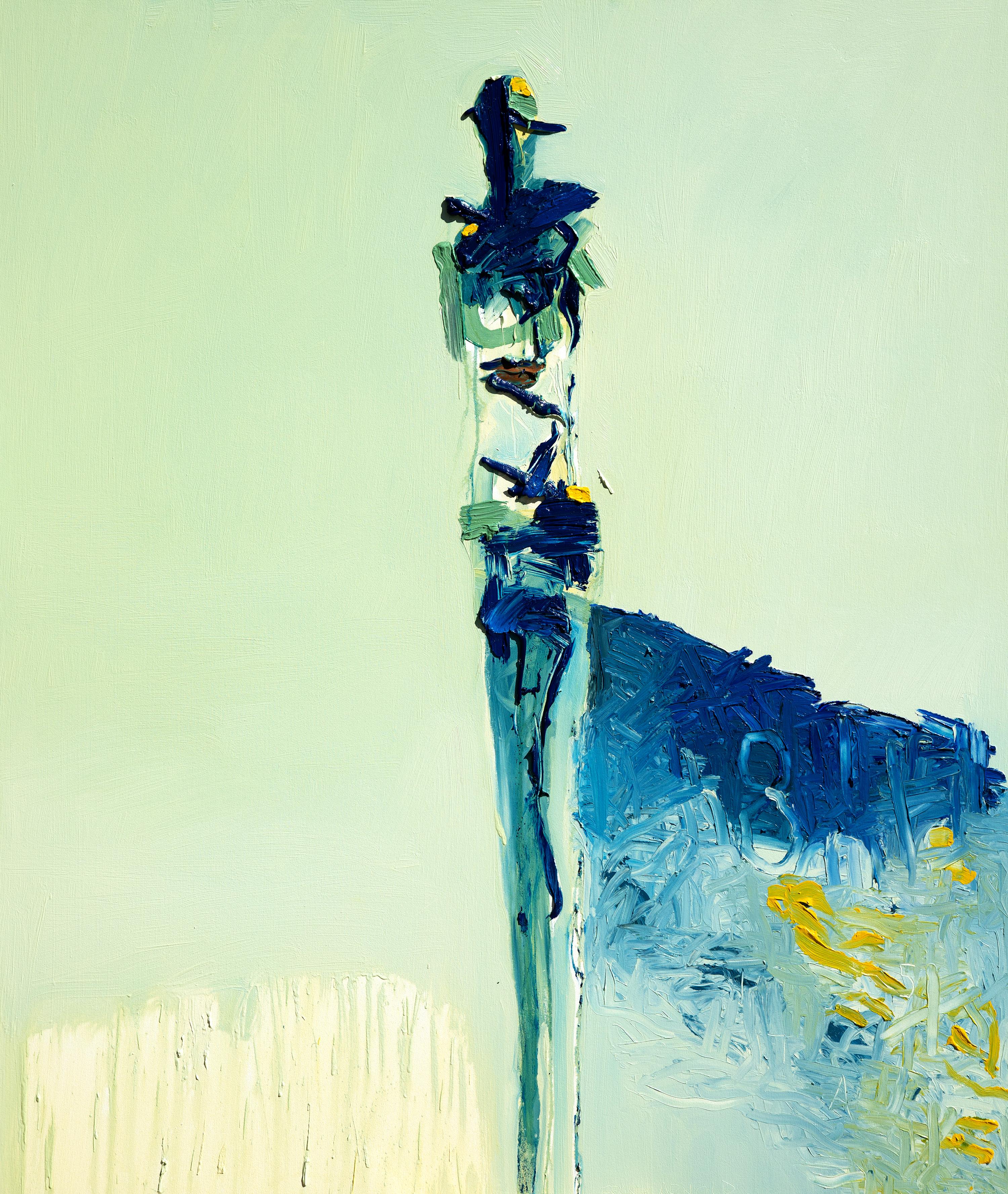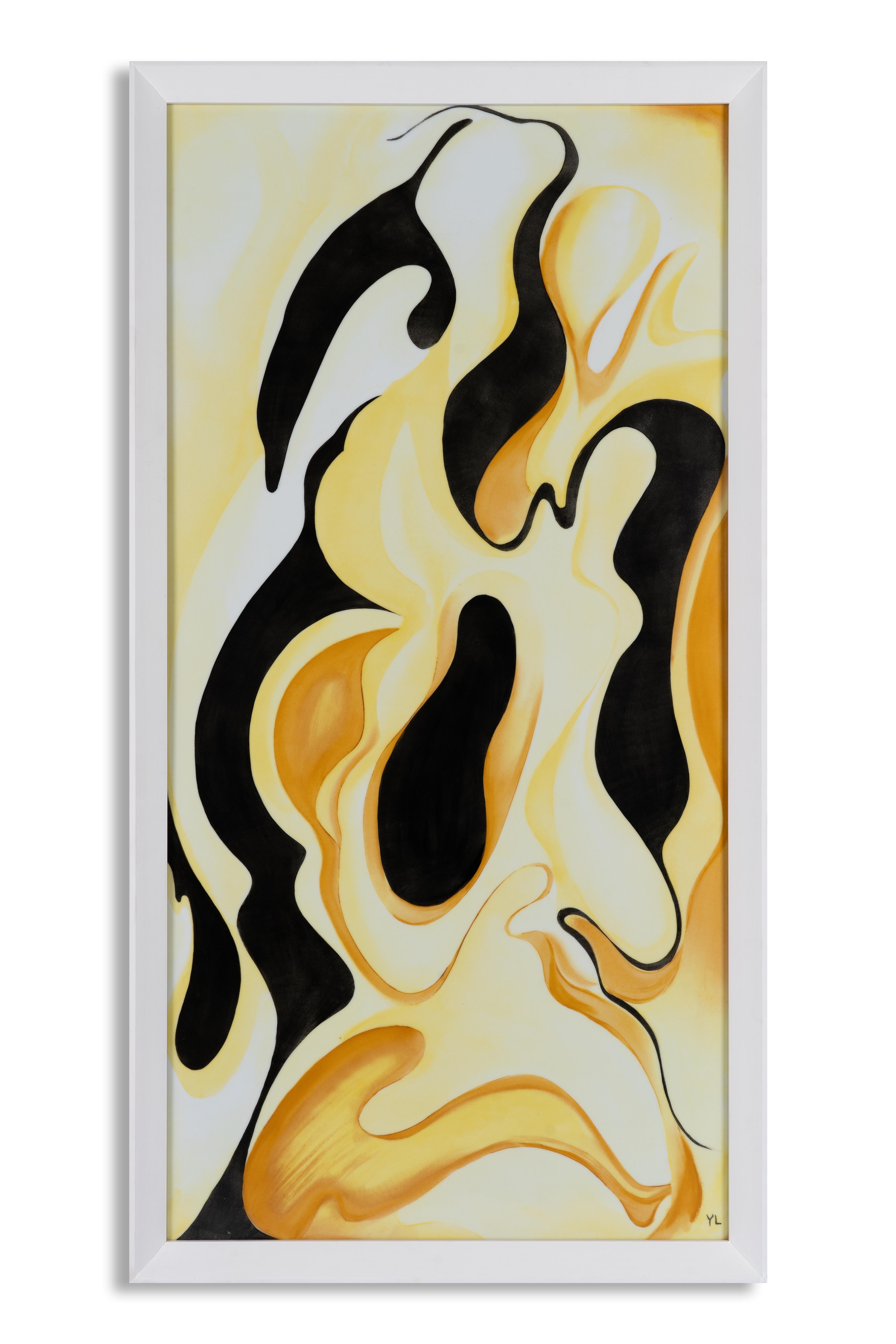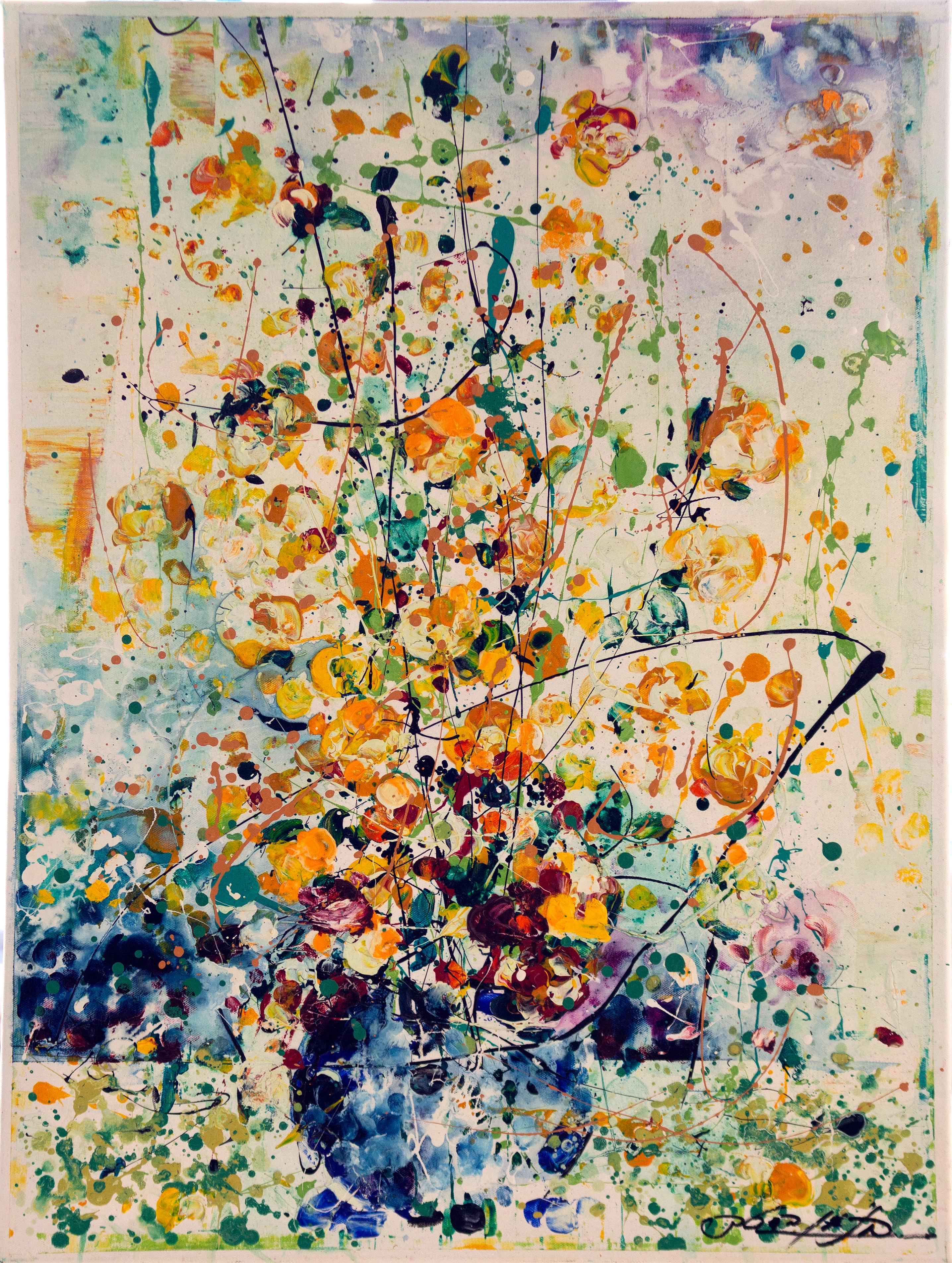Items Similar to Mid-20th Century Abstract Geometric Oil Painting by Cleveland School Artist
Want more images or videos?
Request additional images or videos from the seller
1 of 10
John TeyralMid-20th Century Abstract Geometric Oil Painting by Cleveland School Artist1965
1965
About the Item
John Teyral (American, 1912-1999)
Abstract, 1965
Oil on canvas
Signed and dated lower right
32 x 30 inches
John Teyral was one of Cleveland's most acclaimed artists. He exhibited in galleries across the country and was an award winner in the May Show of the Cleveland Museum of Art for decades. The museum has many of his paintings, and other museums in the country have collected his work. Mr. Teyral also painted portraits of many prominent Clevelanders.
He taught advanced painting at the Cleveland Institute of Art for 40 years.
Mr. Teyral died February 17 in Highlands, N.C. He was 87.
He was born in Yaroslav, Russian, but his family moved to the United States when he was 1. While he was growing up on the near West Side, he took to art the way most boys take to sports. He was 12 when he submitted a drawing at a branch library that won him admission to Saturday classes at the Cleveland Museum of Art. Each year that he was a student at Lincoln High School, he won the Cleveland School of Art's high school competition. When he graduated from the Cleveland Institute of Art in 1934, he received an Agnes Gund traveling scholarship to study at the Boston Museum School of Fine Arts.
In 1938 he attended Ecole de la Grande Chaumiere in Paris. After World War II, he studied at Accademia di Belli Arti in Florence, Italy, through a Fulbright grant.
Mr. Teyral made a number of study trips to Europe, north Africa, Mexico and the Caribbean Islands.
In addition to fine arts painting, Mr. Teyral did commercial art for McCann-Erickson Advertising Agency in the 1930s and 1940s.
He lived in Cleveland Heights for many years. He moved to Highlands, N.C., in the 1970s.
- Creator:John Teyral (1912 - 1999, American)
- Creation Year:1965
- Dimensions:Height: 32 in (81.28 cm)Width: 30 in (76.2 cm)
- Medium:
- Movement & Style:
- Period:
- Condition:
- Gallery Location:Beachwood, OH
- Reference Number:1stDibs: LU1768213198792
About the Seller
No Reviews Yet
Vetted Seller
These experienced sellers undergo a comprehensive evaluation by our team of in-house experts.
Established in 1975
1stDibs seller since 2022
9 sales on 1stDibs
Typical response time: 19 hours
- ShippingRetrieving quote...Ships From: Beachwood, OH
- Return PolicyA return for this item may be initiated within 14 days of delivery.
More From This SellerView All
- Large 20th century abstract painting by contemporary Ohio artist, 3.5 x 4.5 feetLocated in Beachwood, OHJames Lepore (American, 20th Century) Untitled (Abstract), 1962 Oil on canvas Signed Lepore 62 lower right 43 x 55 inches James Lepore is an American art...Category
1960s Abstract Abstract Paintings
MaterialsOil
- Magic Garden, vibrant mid-century abstract expressionist colorful geometric workBy Richard AndresLocated in Beachwood, OHRichard Andres (American, 1927-2013) Magic Garden, c. 1962 oil on canvas signed lower left, signed and titled verso 50 x 42 inches Richard Andres was born in Buffalo, New York in 19...Category
1960s Abstract Expressionist Abstract Paintings
MaterialsOil
- By the Dawn's Early Light, mid-century abstract black, red, yellow oil paintingBy Charles Green ShawLocated in Beachwood, OHCharles Green Shaw (American, 1892-1974) By the Dawn's Early Light, 1955 Oil on masonite Signed lower left, dated and titled verso 35.5 x 23.75 inches 38 x 26.25 inches, framed Provenance: The estate of the artist to Charles H. Carpenter Charles Green Shaw, born into a wealthy New York family, began painting when he was in his mid-thirties. A 1914 graduate of Yale, Shaw also completed a year of architectural studies at Columbia University. During the 1920s Shaw enjoyed a successful career as a freelance writer for The New Yorker, Smart Set and Vanity Fair, chronicling the life of the theater and café society. In addition to penning insightful articles, Shaw was a poet, novelist and journalist. In 1927 he began to take a serious interest in art and attended Thomas Hart Benton's class at the Art Students League briefly in New York. He also studied privately with George Luks, who became a good friend. Once he had dedicated himself to non-traditional painting, Shaw's writing ability made him a potent defender of abstract art. After initial study with Benton and Luks, Shaw continued his artistic education in Paris by visiting numerous museums and galleries. From 1930 to 1932 Shaw's paintings evolved from a style imitative of Cubism to one directly inspired by it, though simplified and more purely geometric. Returning to the United States in 1933, Shaw began a series of abstracted cityscapes of skyscrapers he called Manhattan Motifs which evolved into his most famous works, the shaped canvases he called Plastic Polygons. The 1930s were productive years for Shaw. He showed his paintings in numerous group exhibitions, both in New York and abroad, and was also given several one-man exhibitions. Shaw had his first one-man exhibition at the Valentine Dudensing Gallery in New York in 1934, which included 25 Manhattan Motif paintings and 8 abstract works. In the spring of 1935 Shaw was introduced to Albert Gallatin and George L.K. Morris. Gallatin was so impressed with Shaw's work, he broke a policy against solo exhibitions at his museum, the Gallery of Living Art, and offered Shaw an exhibition there. In the summer of 1935 Shaw traveled to Paris with Gallatin and Morris who provided introductions to many great painters. Shaw regularly spent time with John Ferren and Jean Hélion. The following year Gallatin organized an exhibition called Five Contemporary American Concretionists at the Reinhardt Gallery that included Shaw, Ferren, and Morris, Alexander Calder, and Charles Biederman...Category
1950s Abstract Abstract Paintings
MaterialsOil
- Semi-abstract Still Life, Large 20th Century Blue & Pink Oil PaintingBy John HelikerLocated in Beachwood, OHJohn Heliker (American, 1909-2000) Still Life with Sugar Bowl Oil on canvas Signed lower right 39.75 x 39.75 inches 45.5 x 45.5 inches, framed Provenance: Private Collection Ypsilant...Category
20th Century Abstract Impressionist Still-life Paintings
MaterialsOil
- Naval Occurrence, orange, blue & green mid-century, abstract geometrical workBy Richard AndresLocated in Beachwood, OHRichard Andres (American, 1927-2013) Naval Occurrence, c. 1963 oil on canvas signed and titled verso 24 x 32 inches Richard Andres was born in Buffalo, New York in 1927. A graduate of the Cleveland Institute of Art in 1950, he was immediately drafted and served for two years in the army as a mural painter. He received his Master of Arts from Kent State in 1961. A frequent exhibitor at galleries and museums and winner of multiple May Show prizes, Andres taught art in the Cleveland Public Schools for 28 years, as well as teaching the University of Buffalo, the Cleveland Institute of Art and the Western Reserve University. Very little in Richard Andres’ childhood would have predicted his love of classical music, mid-century-modern architecture and certainly not his lifelong passion for art and in particular abstract art. Richard’s father, Raymond, had no more than a third-grade education, and his mother, Clara, was one of thirteen children – only three of whom lived into adulthood and none of whom attended high school. They lived, when Richard was a boy, in a dingy area of Buffalo, NY in a walk-up apartment situated above a tavern. Raymond and Clara supplemented the income from their factory jobs in the bar downstairs with Raymond playing ragtime on the piano and Clara serving drinks. This often left Richard and his two older brothers at home alone to fend for themselves. The two older boys, Raymond and Russell, were - unlike Richard- rather rough and tumble and entertained themselves with stickball, boxing and the like. Richard, on the other hand, from a very young age liked to draw, or better yet even, to paint with the small set of watercolors he received for Christmas one year. Paper, however, at the height of the depression, was hard to come by. Luckily, Clara used paper doilies as decoration for the apartment and Richard would contentedly paint and then cut up doilies, gluing the pieces together to create collages. At eight-years-old, he discovered the Albright-Knox Museum (then known as the Albright Art Gallery) and spent several hours a week there studying the paintings. He was particularly fond of Charles Burchfield‘s landscapes, enamored with their ‘messiness’ and thinking that they somehow captured more ‘feeling’ than works he was previously familiar with. For his tenth Christmas, he asked for and received a ‘how-to’ paint book by Elliot O’Hare. Through this self-teaching, he assembled the portfolio needed for acceptance to Buffalo Technical High School where he studied Advertising Arts. In his Junior year, he was encouraged to enter a watercolor painting, “Two Barns,” in the national 1944-45 Ingersoll Art Award Contest and was one of twelve grand prize winners – each one winning one hundred dollars. More importantly the painting was exhibited at the Carnegie Institute Galleries, which resulted in his winning a national scholarship to the Cleveland School of Art (The Cleveland Art Institute). He flourished at the art school under the tutelage of faculty members such as Carl Gaertner, as well as that of visiting artists such as William Sommer and Henry George Keller. He would say in later years that Gaertner, in particular, influenced his attitude toward life as well as art. “Gaertner,” Andres said, “believed that there was no need to be a ‘tortured artist’, that an artist should rather enjoy beauty, family, and life in general.” Free to spend his days as he chose, he wandered the Cleveland Art Museum for most of the hours he was not attending classes or painting; the remaining time was spent drinking coffee at a local hangout with art school friends – which is where he met fellow Henry Keller scholarship winner, Avis Johnson. Richard was immediately smitten with Avis, but being rather shy, it took him the entire summer of 1948 to build up his courage to ask her out. Over that summer he ‘thought about Avis’ and worked in a diner to save money. He also used the hundred-dollar prize money won in High School to visit the first Max Beckmann retrospective in the United States at the City Art Museum in St. Louis. Over a half century later he spoke of that exhibit with a reverence usually reserved for spiritual matters, “I walked in and it was like nothing I had ever seen before... the color...It just glowed.” Returning to campus in the Fall, the first thing he did was go to the coffee shop in hopes of finding Avis. He did, and she, upon seeing him, realized that she was also smitten with him. They quickly became known as ‘the couple’ on campus, and a year later, with Richard being drafted for the Korean war, they were quickly married by a Justice of the Peace, celebrating after with family at Avis’s Cleveland home. As a gift, faculty member John Paul Miller designed and made the simple gold wedding ring Avis wore for their 65 years of marriage. During those 65 years neither wavered in their mutual love, nor in the respect they shared for one another’s art. The couple lived in a converted chicken coop in Missouri while Richard was in boot camp. At the camp, he would volunteer for any job offered and one of those jobs ended up being painting road signs. His commander noticed how quickly and neatly he worked and gave him more painting work to do - eventually recommending him for a position painting murals for Army offices in Panama. Until her dying day, Avis remained angry that “The army got to keep those fabulous murals and they probably didn’t even know how wonderful they were.” In Panama, their first son, Mark, was born. After Richard’s discharge in 1953, they moved back to the Cleveland area and used the GI bill to attend Kent State gaining his BA in education. The small family then moved briefly to Buffalo, where Richard taught at the Albright Art School and the University of Buffalo – and their second son, Peter, was born. Richard had exhibited work in the Cleveland May Show and the Butler Art Museum during his art school years, and during the years in Buffalo, his work was exhibited at the gallery he had so loved as a child, the Albright Art Gallery. In 1956, the family moved back to the Cleveland area and Richard began teaching art at Lincoln West High School during the day while working toward his MA in art at Kent State in the evenings. Avis and Richard, with the help of an architect, designed their first home - a saltbox style house in Hudson, Ohio, and in 1958, their third son, Max (after Max Beckmann) was born. Richard enjoyed the consistency of teaching high school as well as the time it gave him to paint on the weekends and during the summer months. In 1961, he received his MA and his daughter, Claire, was born. With a fourth child, the house was much too small, and Avis and Richard began designing their second home. An admirer of MCM architecture, Richard’s favorite example of the style was the Farnsworth house – he often spoke of how the concepts behind this architectural style, particularly that of Mies van der Rohe, influenced his painting. Andres described himself as a 1950’s...Category
1960s Abstract Geometric Abstract Paintings
MaterialsOil
- Abstract expressionist blue, black & green mid-century geometric paintingBy Richard AndresLocated in Beachwood, OHRichard Andres (American, 1927-2013) Untitled, c. 1949 oil on canvas 18 x 32 inches Richard Andres was born in Buffalo, New York in 1927. A graduate of the Cleveland Institute of Art in 1950, he was immediately drafted and served for two years in the army as a mural painter. He received his Master of Arts from Kent State in 1961. A frequent exhibitor at galleries and museums and winner of multiple May Show prizes, Andres taught art in the Cleveland Public Schools for 28 years, as well as teaching the University of Buffalo, the Cleveland Institute of Art and the Western Reserve University. Very little in Richard Andres’ childhood would have predicted his love of classical music, mid-century-modern architecture and certainly not his lifelong passion for art and in particular abstract art. Richard’s father, Raymond, had no more than a third-grade education, and his mother, Clara, was one of thirteen children – only three of whom lived into adulthood and none of whom attended high school. They lived, when Richard was a boy, in a dingy area of Buffalo, NY in a walk-up apartment situated above a tavern. Raymond and Clara supplemented the income from their factory jobs in the bar downstairs with Raymond playing ragtime on the piano and Clara serving drinks. This often left Richard and his two older brothers at home alone to fend for themselves. The two older boys, Raymond and Russell, were - unlike Richard- rather rough and tumble and entertained themselves with stickball, boxing and the like. Richard, on the other hand, from a very young age liked to draw, or better yet even, to paint with the small set of watercolors he received for Christmas one year. Paper, however, at the height of the depression, was hard to come by. Luckily, Clara used paper doilies as decoration for the apartment and Richard would contentedly paint and then cut up doilies, gluing the pieces together to create collages. At eight-years-old, he discovered the Albright-Knox Museum (then known as the Albright Art Gallery) and spent several hours a week there studying the paintings. He was particularly fond of Charles Burchfield‘s landscapes, enamored with their ‘messiness’ and thinking that they somehow captured more ‘feeling’ than works he was previously familiar with. For his tenth Christmas, he asked for and received a ‘how-to’ paint book by Elliot O’Hare. Through this self-teaching, he assembled the portfolio needed for acceptance to Buffalo Technical High School where he studied Advertising Arts. In his Junior year, he was encouraged to enter a watercolor painting, “Two Barns,” in the national 1944-45 Ingersoll Art Award Contest and was one of twelve grand prize winners – each one winning one hundred dollars. More importantly the painting was exhibited at the Carnegie Institute Galleries, which resulted in his winning a national scholarship to the Cleveland School of Art (The Cleveland Art Institute). He flourished at the art school under the tutelage of faculty members such as Carl Gaertner, as well as that of visiting artists such as William Sommer and Henry George Keller. He would say in later years that Gaertner, in particular, influenced his attitude toward life as well as art. “Gaertner,” Andres said, “believed that there was no need to be a ‘tortured artist’, that an artist should rather enjoy beauty, family, and life in general.” Free to spend his days as he chose, he wandered the Cleveland Art Museum for most of the hours he was not attending classes or painting; the remaining time was spent drinking coffee at a local hangout with art school friends – which is where he met fellow Henry Keller scholarship winner, Avis Johnson. Richard was immediately smitten with Avis, but being rather shy, it took him the entire summer of 1948 to build up his courage to ask her out. Over that summer he ‘thought about Avis’ and worked in a diner to save money. He also used the hundred-dollar prize money won in High School to visit the first Max Beckmann retrospective in the United States at the City Art Museum in St. Louis. Over a half century later he spoke of that exhibit with a reverence usually reserved for spiritual matters, “I walked in and it was like nothing I had ever seen before... the color...It just glowed.” Returning to campus in the Fall, the first thing he did was go to the coffee shop in hopes of finding Avis. He did, and she, upon seeing him, realized that she was also smitten with him. They quickly became known as ‘the couple’ on campus, and a year later, with Richard being drafted for the Korean war, they were quickly married by a Justice of the Peace, celebrating after with family at Avis’s Cleveland home. As a gift, faculty member John Paul Miller designed and made the simple gold wedding ring Avis wore for their 65 years of marriage. During those 65 years neither wavered in their mutual love, nor in the respect they shared for one another’s art. The couple lived in a converted chicken coop in Missouri while Richard was in boot camp. At the camp, he would volunteer for any job offered and one of those jobs ended up being painting road signs. His commander noticed how quickly and neatly he worked and gave him more painting work to do - eventually recommending him for a position painting murals for Army offices in Panama. Until her dying day, Avis remained angry that “The army got to keep those fabulous murals and they probably didn’t even know how wonderful they were.” In Panama, their first son, Mark, was born. After Richard’s discharge in 1953, they moved back to the Cleveland area and used the GI bill to attend Kent State gaining his BA in education. The small family then moved briefly to Buffalo, where Richard taught at the Albright Art School and the University of Buffalo – and their second son, Peter, was born. Richard had exhibited work in the Cleveland May Show and the Butler Art Museum during his art school years, and during the years in Buffalo, his work was exhibited at the gallery he had so loved as a child, the Albright Art Gallery. In 1956, the family moved back to the Cleveland area and Richard began teaching art at Lincoln West High School during the day while working toward his MA in art at Kent State in the evenings. Avis and Richard, with the help of an architect, designed their first home - a saltbox style house in Hudson, Ohio, and in 1958, their third son, Max (after Max Beckmann) was born. Richard enjoyed the consistency of teaching high school as well as the time it gave him to paint on the weekends and during the summer months. In 1961, he received his MA and his daughter, Claire, was born. With a fourth child, the house was much too small, and Avis and Richard began designing their second home. An admirer of MCM architecture, Richard’s favorite example of the style was the Farnsworth house – he often spoke of how the concepts behind this architectural style, particularly that of Mies van der Rohe, influenced his painting. Andres described himself as a 1950’s...Category
1940s Abstract Expressionist Abstract Paintings
MaterialsOil
You May Also Like
- Oil on Canvas “Back Again”By Frank ArnoldLocated in Fresno, CAFrank Arnold is thought by many to be one of the foremost abstract figurative painters and sculptors of our time. He is a living master whose work is considered to be both personal a...Category
21st Century and Contemporary Abstract Abstract Paintings
MaterialsOil
- New MoveBy Frank ArnoldLocated in Fresno, CA"New Move 8" Oil on Canvas is a mix of blues and greens with chrome yellow accents. Frank Arnold is thought by many to be one of the foremost abstract figurative painters and sculpto...Category
2010s Abstract Abstract Paintings
MaterialsCanvas, Oil
- Bleeding Icon IIIBy Dirk de BruyckerLocated in Rio Vista, CADirk De Bruycker (Dutch/American 1955-2015) abstract painting Bleeding Icon III 1996. One of this artists most dramatic paintings using asphalt, gesso, a...Category
Late 20th Century Abstract Abstract Paintings
MaterialsAsphaltum, Gesso, Canvas, Oil
- DaydreamsLocated in Southampton, NYPart of a new collection of painted porcelain panels by Chinese artist Yuan Lin, “Daydreams” is a luminous meditation on the sun's rays. In this painting, Lin...Category
2010s Abstract Expressionist Abstract Paintings
MaterialsCeramic, Glaze, Oil
- Mindy Weisel, Not Everything is Black and White , 2017 oil on canvas 91 x 91By Mindy WeiselLocated in Jerusalem, ILMindy Weisel Not Everything is Black and White , 2017 oil on canvas 91 x 91 cm 36 x 36 in Exhibited Mindy Weisel "Meditations on Love", Rosenbach Conte...Category
2010s Abstract Expressionist Abstract Paintings
MaterialsCanvas, Oil
- Binyamin Basteker, The sounds of flowers (Jerusalem flower series) oil on canvasLocated in Jerusalem, ILBinyamin Basteker The sounds of flowers , 2020 oil on canvas 80 x 60 cm 31 x 24 in Exhibited: "Jerusalem Flowers", 2020 Rosenbach Contemporary, Jerusalem Binyamin Basteker was bo...Category
2010s Abstract Expressionist Abstract Paintings
MaterialsOil




